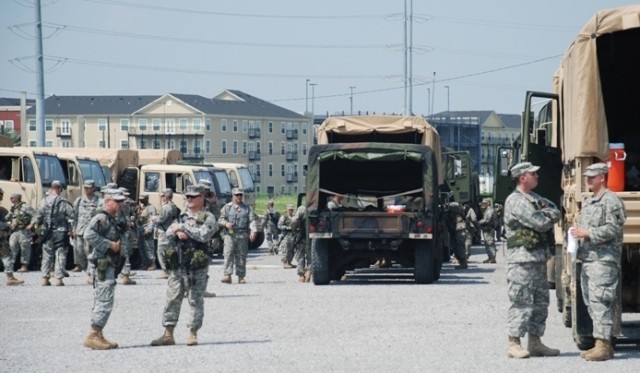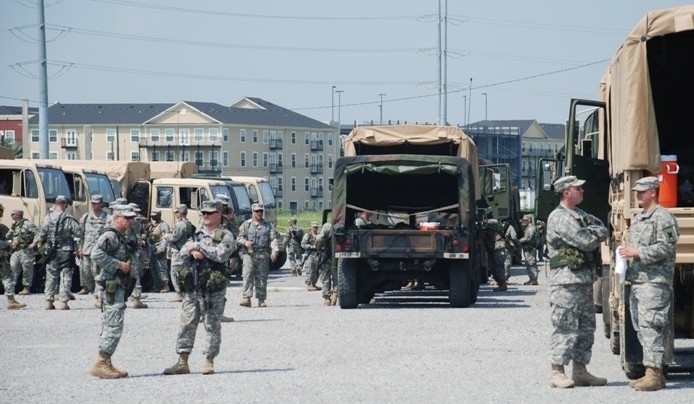
WASHINGTON (Army News Service, Sept. 2, 2008) -The Army launched the "Ready Army" campaign Sept. 2, in conjunction with the Department of Homeland Security's National Preparedness Month, which encompasses the seventh anniversary of the terrorist attacks of Sept. 11, 2001.
Ready Army is designed to prepare the entire Army family at installations and communities across the nation and around the world for all potential hazards, natural and manmade, officials said.
"While partnered and aligned with the Department of Homeland Security's national preparedness campaign called 'Ready,' Ready Army is specific to Army communities and is intended for use at the installation level," said James Platt, chief of the Asymmetrical Warfare Office's Protection Division. "Quite a few products have been developed for Soldiers, civilians and their families to inform them about all types of hazards and encouraging individual, family and community emergency preparedness," Platt said.
Materials being sent to installations include an implementation guide, public service announcements, briefings, brochures, posters, emergency management kit information and readiness checklists, family emergency management planning templates, an electronic media kit, children's activities, parent/teacher resource guide and web-based tools.
"At command and installation levels we're asking that public affairs offices partner with their emergency preparedness personnel, directors of Plans, Training, Mobilization and Security, first responders and family program personnel to promote this program," said Col. Jon Dahms, chief of Planning Support in Army public affairs. "This program will educate our Families on disaster preparedness and motivate them to 'Get a Kit, Make a Plan and Be Informed,' as the program's motto encourages," Dahms said.
Patricia Powell, Ready Army program manager, said the campaign's concepts were tested in a one-year pilot program at Fort Hood, Texas, and at Army installations in Germany.
"In March, during Ready Army Week, Fort Hood emergency preparedness personnel worked with city officials of nearby Killeen to distribute brochures and pamphlets that provide valuable information about how to prepare for emergencies," said Powell.
As part of an after-action report provided by the Fort Hood pilot program, the Army has identified several "best practices" that other installations should consider as they launch this program at the local and installation level. They are:
Aca,!Ac Secure leadership buy-in: Brief senior leadership on both garrison and mission sides, and area civic and community leaders.
Aca,!Ac Have a campaign strategy ready by working closely with Morale, Welfare and Recreation and the Public Affairs Office.
Aca,!Ac Integrate Ready Army across the installation, all units, organizations and local community partnerships through a variety of outreach methods, including proclamations, brochures, promotional items, speaking engagements, and media coverage.
Aca,!Ac Have Ready Army fact sheets available for all types of emergencies. For example, tornado, flood, hurricane, lightning, wildfires, house fires and even school shootings. Let Ready Army sell itself as important every day, every month, every year.
Aca,!Ac Place static displays in areas of greatest outreach potential on post and in the community.
Mark Peterson, a Fort Hood Chemical, Biological, Radiological, Nuclear, or high-yield Explosives operations specialist, started at the top by presenting the Ready Army campaign to Fort Hood and community leaders in the fall of 2007 at a meeting that focused on children.
The quarterly "Fort Hood 2020" meeting is attended by installation commanders, senior spouses, area school district superintendents, and educational partners. Originally founded in the 1990s by a Fort Hood commander, the program is intended to identify issues and brainstorm solutions regarding about 30,000 area military students and their education.
At a kickoff ceremony, Fort Hood's installation commander signed a proclamation that urged all residents to become active in emergency preparedness. The mayor of Killeen urged the city to do the same, signing a twin proclamation.
"This was the springboard," Peterson said. "Our community is very supportive."
The City of Killeen received a $20,000 grant to assist with the community effort, Peterson said.
In addition to these best practices, some ideas for events and promotions at the installations are school activities to educate children on the need for a family plan so they know where to go and what to do in an emergency; displays at commissaries and post exchanges highlighting the program; emergency preparedness exercises and demonstrations highlighting the program; presentations and demonstrations by local emergency preparedness personnel and installation-sponsored safety programs.
Another key part of National Preparedness Month will be the debut of the Army Disaster Personnel Accountability and Assessment System or ADPAAS, officials said, adding that this will be the official Army tool for personnel accountability in the event of a natural or man-made disaster.
"Hurricane Katrina caught the services off guard with no real procedures in place to gain and maintain accountability of personnel and their family members," said Lt. Col. Trudy Leonard, chief of the Personnel Contingency Cell for the Army G-1.
ADPAAS was built based on a directive from the Department of Defense to address this issue. This Web-based tool allows Families to update information by using the internet or calling a toll-free number. In addition, ADPAAS will assist officials to determine the status of Army Families and then provide assistance as needed. For more information on ADPAAS, visit: <a href="https://adpaas.army.mil"target=_blank> adpaas.army.mil.</a>
"The bottom line is that preparedness increases the resiliency of America's fighting forces and supports Soldiers who are forward-deployed," Leonard said. "We want our Soldiers downrange to feel comfortable that their Families are being taken care of at home."

Social Sharing